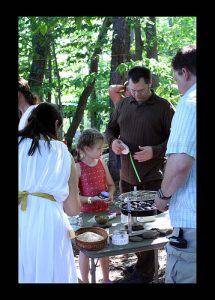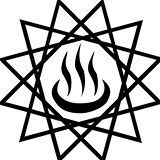by Melissa edited by various authors
(23-30 Hekatombaion) The premier festival of the year, the Panathenaia was the celebration of the birthday of the city. Beginning in the 7th century BCE, the annual festival, the Panathenaia ta mikra (Lesser Panathenaia), involved an impressive procession from outside the walls of the city to the Acropolis. This procession was depicted on the frieze of the Acropolis. The main purpose of the procession was to convey the new peplos for the image of Athena, but during Classical times, the festival acquired increased political importance. The loom for this peplos had been set up at the festival of Khalkeia (in Pyanepsion), nine months before, by priestesses and young girls (Arrephoroi) particularly dedicated to the worship of Athena and the weaving had been carried out by the Ergastiai (workers), maidens chosen from Aristocratic families. Now the colossal wool garment, with traditional yellow and blue decoration woven into it was carried in a ship-like cart. Everyone in Attica took part: Kanephoroi, young women who bear baskets on their heads (containing the meal/grain to through on the sacrificial victim); Diphrophoroi (Chair bearers), young girls carrying chairs; Thallophoroi, green branch bearers who were old men; young men wearing purple robes (the Skaphephoroi, or tray-bearers) of the resident non-citizens carried trays of cakes and honeycombs as offerings; daughters of Metics carried water jars; and freed slaves and other non-Greeks carried oak branches. Representatives of subject city states of the empire brought suits of armor and a cow as offerings and all of them were likely in the parade as well.
The annual Panathenaia included several other distinctive elements: a torch race, an all-night service (the Pannychis) and a meat meal for everyone at the city’s expense. The torch race (run by Athenians only) involves a contest of single runners carrying torches lit from the fire on the altar of Eros in the Academy outside the Dipylon Gate and was a two-mile uphill race ending at the Acropolis. The first runner one to arrive with a torch still alight was the winner and his torch was used to light the fire to burn the sacrifices.
Then in 566/5 BCE, athletic games open to all Greeks were added to the festival so that, every fourth year, the city observed Panathenaia ta megala (Great Panathenaia). And late in the 6th century, the tyrant Peisistratos added musical competitions and recitations of the poetry of Homer. Athletic events included foot-race (stadion), pentathlon, wrestling, boxing and pankration, in three age categories: men, beardless youths and boys. Horse competition were also held, including four-horse chariot, two-horse chariot, horses ridden singly, javelin-throwing from horseback and races for foals as well as full-grown horses. Winners received, among other things, olive oil purportedly from the sacred olive tree of Athena in distinctive white and black amphoras. Unlike at the Olympics, there were also second-places prizes (Parke 33-49).

On one or more of the days from the 23rd to the 30th of Hekatombaion (best date is the 28th, according to Adkins & Adkins 351), we should honor Athena in any way “that you can, with offerings, prayers, reading of Hymns” (Orphic Hymn 32 and Homeric Hymn 28) and in a communal meal. If you can, plan night-time worship, beginning at sunset. And if you have enough people, you can stage running races and other contests and perhaps even a procession, if not a race, of torches at night or before dawn. Include the study of Athenian history, art and architecture.
Sources:
Adkins, Lesley and Roy A. Adkins, Handbook to Life in Ancient Greece, 1997
Apollonius Sophistes, “Seasonal Festivals of the Greeks and Romans”
Burkert, Walter, Greek Religion, English version 1985
Parke, H. W., Festivals of the Athenians, 1977
